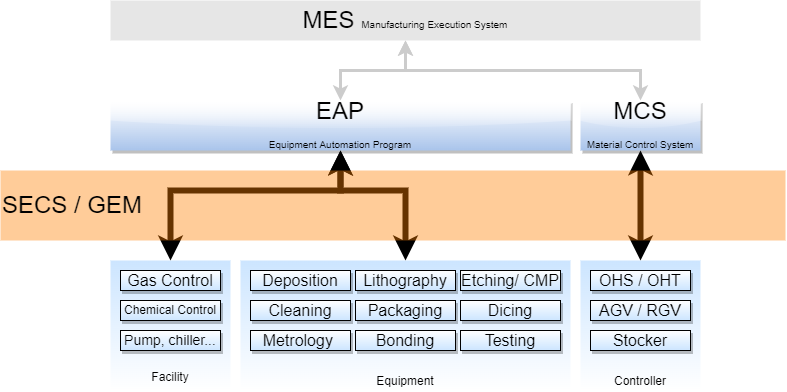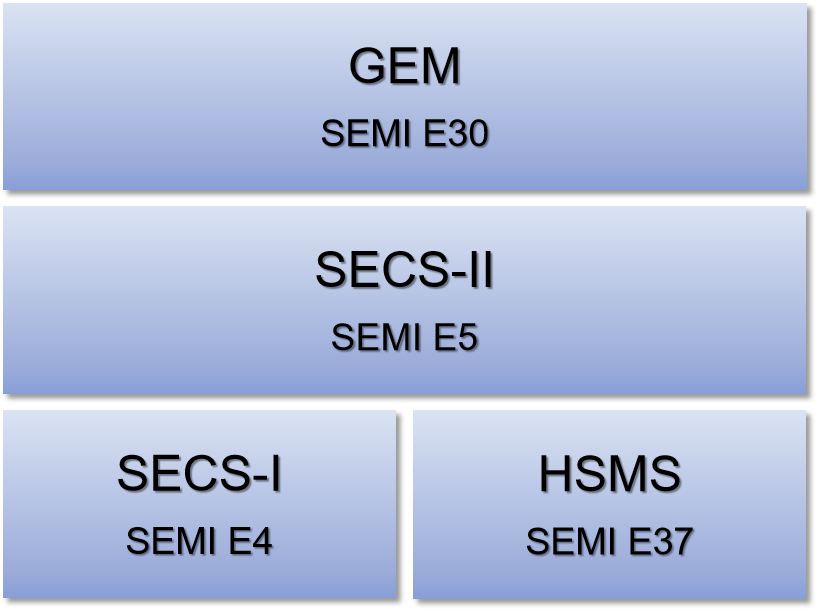SECS/GEM stands for “SEMI Equipment Communications Standard / Generic Equipment Model.” It is a set of communication protocols established by SEMI . It covers widely range from not only the details in communication between equipment and its host but also the expected behavior equipment in various situations. It’s initially used in the semiconductor industry. And due to its comprehensive definition of equipment communication and behavior, it has gradually expanded to other fields such as Printed Circuit Board (PCB) manufacturing, Photovoltaic (PV) industry, Light Emitting Diode (LED) industry, and Flat-panel Display (FPD) industry.
Role in Semiconductor FABs
SECS/GEM is an international standard for semiconductor equipment communication. As long as the data, generated by tiny sensors or process equipment, is required for manufacturing, they are sent to Equipment Automation Programs (EAP) using this standard, as illustrated in the yellow section in Figure 1.

Due to its maturity and widespread use in process equipment, SECS/GEM has gradually expanded to include some non-process equipment as well. For instance, SECS or HSMS is commonly observed between the Material Control System (MCS) and its corresponding controller, as shown on the right side of Figure 1. Considering the prevalence of SECS/GEM in semiconductor FABs, it wouldn’t be an exaggeration to say that it serves as the official language of semiconductor FABs.
Scope of SECS/GEM
When referring to this international standard, it typically encompasses SEMI E4 (SECS-I), SEMI E5 (SECS-II), SEMI E30 (GEM), and SEMI E37 (HSMS). The relationships of these four components within the overall architecture of SECS/GEM are shown in Figure 2.

The lower layers, SECS-I and HSMS, focus on message transmission, with the key distinction that SECS-I adopts RS-232 and RS-422 as transmission media, while HSMS typically utilizes Ethernet. In the middle, SECS-II specifies the format and content of messages, referred to as SECS Messages. SECS Messages are categorized based on their types, known as Streams, and each type’s specific functionalities are represented by Functions. Consequently, different SECS Messages are denoted as SxFy or Sm, Sn. At the top layer, GEM defines the SECS Messages that a device should send under various circumstances.
Benefit of SECS/GEM
As GEM defines a framework for device behavior, devices and their hosts (such as EAP) can be independently developed according to this framework. For equipment manufacturers, this specification provides a single standard that can meet the needs of the majority of users. For semiconductor fabs, where equipment comes from different vendors, having all equipment manufacturers adopt the same interface enhances the potential for connectivity and convenience throughout the entire facility. This is one of the key factors that has consistently positioned the semiconductor industry at the forefront of implementing Industrial Internet of Things (IIoT) solutions. It’s also why an increasing number of industries are adopting SECS/GEM as their communication standard.